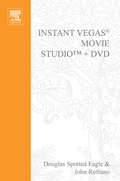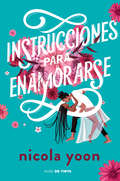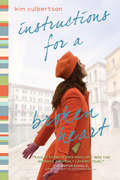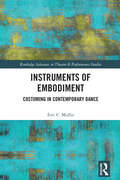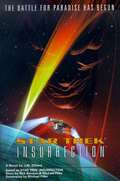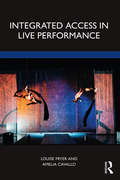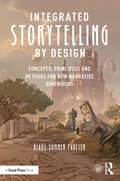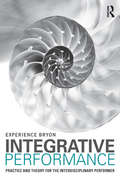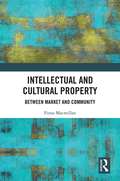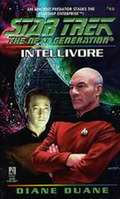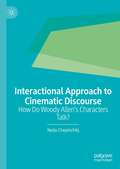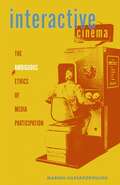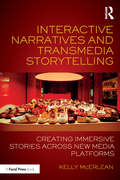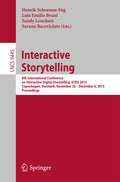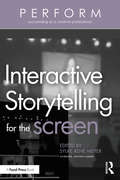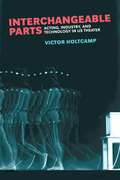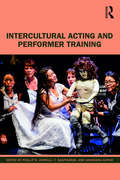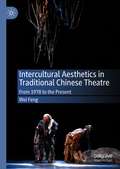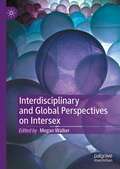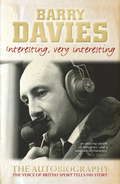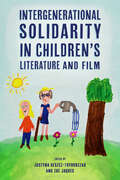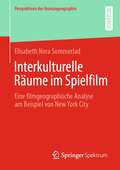- Table View
- List View
Instant Vegas Movie Studio +DVD: VASST Instant Series
by Douglas Spotted EagleCarefully detailed screenshots and step-by-step directions illustrate how to use Sony's new consumer-level video and audio editing applications, in a concise, time-efficient way. Readers learn the rudiments of navigating Vegas Movie Studio and the companion audio applications, Sound Forge Audio Studio and ACID Music Studio, to perform a complete range of tasks, from editing video and audio, to compositing and outputting their final project. This is the eighth book in the new VASST Instant Series produced in cooperation with the Sundance Media Group.
Instrucciones para enamorarse
by Nicola YoonUn libro para enamorarse, incluso para los que ya no creen en el amor. Evie Thomas ya no cree en el amor. Cuando sus padres se separaron, todos sus ideales sobre el amor se esfumaron. Sin embargo, las casualidades de la vida la llevan a aprender a bailar en la Escuela de Baile La Brea, donde conoce a un enigmático chico. X es completamente opuesto a Evie: atrevido, pasional, sin miedo. El tipo de persona que dice sí a todo, incluso a apuntarse a una competición de bailes de salón con una chica que acaba de conocer. Enamorarse de X no es lo que Evie tenía en mente. Si su experiencia le ha enseñado algo, es que nadie escapa del amor sin resultar herido. Pero mientras Evie y X bailan y se conocen más, la magia del amor arrasa con todo. Instrucciones para enamorarse es la nueva novela de Nicola Yoon, la autora bestseller de las novelas Todo todo y El sol también es una estrella. Un libroperfecto para amantes del romance, y para fans de Todo este tiempo o Bajo la misma estrella.
Instructions for a Broken Heart
by Kim CulbertsonThree days before her drama club's trip to Italy, Jessa Gardner discovers her boyfriend in the costume barn with another girl. Jessa is left with a care package from her best friend titled "Top Twenty Reasons He's a Slimy Jerk Bastard," instructing her to do one un-Jessa-like thing each day of the trip. At turns hilarious and heartwrenching, Instructions for a Broken Heart paints a magical Italy in which Jessa learns she must figure out life-and romance-for herself.
Instruments of Embodiment: Costuming in Contemporary Dance (Routledge Advances in Theatre & Performance Studies)
by Eric MullisInstruments of Embodiment draws on fashion theory and the philosophy of embodiment to investigate costuming in contemporary dance. It weaves together philosophical theory and artistic practice by closely analyzing acclaimed works by contemporary choreographers, considering interviews with costume designers, and engaging in practice-as-research. Topics discussed include the historical evolution of contemporary dance costuming, Merce Cunningham’s innovative collaborations with Robert Rauschenberg, and costumes used in Ohad Naharin’s Virus (2001) and in a ground-breaking Butoh solo by Tatsumi Hijikata. The relationship between dance costuming and high fashion, wearable computing, and the role costume plays in dance reconstruction are also discussed and, along the way, an anarchist materialism is articulated which takes an egalitarian view of artistic collaboration and holds that experimental costume designs facilitate new forms of embodied experience and ways of seeing the body. This study will be of great interest to students and scholars working in performance philosophy, philosophy of embodiment, dance and performance studies, and fashion theory.
Insurrection: Star Trek Ix Movie Novelization (Star Trek )
by J M DillardAgainst a background of an idyllic and peaceful world of eternal youth, a damaged Data goes wild, shutting down the isolation devices which conceal a Federation observation post from the native Baku. Picard is informed by the Admiral Dougherty that Data has taken the observation team and a party of Son'a delegates hostage. Now Picard enters a race against time to shut Data down and rescue the hostages. But the hostages, who are growing younger, have no desire to leave and Picard finds himself facing a terrible conflict between his principles and his orders from Starfleet.
Intangible Cultural Heritage and New Methodological Frameworks: Media, Performance and the Public Space (Routledge Research in Cultural and Media Studies)
by Eleftheria Rania Kosmidou Leslie Grace McMurtryThis book examines media, performance, and the public space as sites of intangible cultural heritage – a heritage that moves beyond physical museums and monuments to encompass film and media, performing arts, oral traditions, social practices, rituals, artifacts, and cultural spaces.Focusing on the current methodological challenges and new frameworks that surround the study of intangible cultural heritage in the public space, this volume explores the ways in which intangible cultural heritage is formed, represented, appropriated, and changed. The authors propose a broad understanding of cultural heritage emerging from the public sphere, encompassing museums, oral traditions, performing arts, social practices, artifacts, media and cultural spaces as the inclusive, collective cultural expressions of everyday culture.This unique and interdisciplinary volume will interest scholars and students of cultural studies, cultural heritage, media and film studies, performance studies, history, and sociology.
Integrated Access in Live Performance
by Louise Fryer Amelia CavalloTwelve per cent of UK theatregoers have a disability. This compares with 18% of the UK’s adult population. Directors can help build audiences as diverse as the population at large by making their art accessible to all. Live performances are increasingly being made accessible to people with sensory impairments not only to satisfy equality laws and the requirements of funding bodies, but also in the interest of diversity and as a catalyst for creativity. But how do you ensure you don’t throw out the access baby with the artistic bathwater? This book draws on the results of the Integrated Access Inquiry: Is It Working? A qualitative study with 20 theatremakers from around the UK, it was commissioned by Extant Theatre – the UK’s leading company of blind and visually impaired people, and combines feedback from disabled audiences with advice from the creative teams who have experimented with integrating access. It discusses the challenges and opportunities of working with disabled actors and building in audience access even before rehearsals begin. It offers strategies, case studies and a step-by-step guide to help creative people integrate access into their live performance for the benefit of all.
Integrated Storytelling by Design: Concepts, Principles and Methods for New Narrative Dimensions
by Klaus Sommer PaulsenThis pioneering work equips you with the skills needed to create and design powerful stories and concepts for interactive, digital, multi-platform storytelling and experience design that will take audience engagement to the next level. Klaus Sommer Paulsen presents a bold new vision of what storytelling can become if it is reinvented as an audience-centric design method. His practices unlock new ways of combining story with experience for a variety of existing, new and upcoming platforms. Merging theory and practice, storytelling and design principles, this innovative toolkit instructs the next generation of creators on how to successfully balance narratives, design and digital innovation to develop strategies and concepts that both apply and transcend current technology. Packed with theory and exercises intended to unlock new narrative dimensions, Integrated Storytelling by Design is a must-read for creative professionals looking to shape the future of themed, branded and immersive experiences.
Integrative Performance: Practice and Theory for the Interdisciplinary Performer
by Experience BryonIntegrative Performance serves a crucial need of 21st-century performers by providing a transdisciplinary approach to training. Its radical new take on performance practice is designed for a climate that increasingly requires fully rounded artists. The book critiques and interrogates key current practices and offers a proven alternative to the idea that rigorous and effective training must separate the disciplines into discrete categories of acting, singing, and dance. Experience Bryon’s Integrative Performance Practice is a way of working that will profoundly shift how performers engage with their training, conditioning and performance disciplines. It synthesizes the various elements of performance work in order to empower the performer as they practice across disciplines within any genre, style or aesthetic. Theory and practice are balanced throughout, using: Regular box-outs, introducing the work's theoretical underpinnings through quotes, case studies and critical interjections. A full program of exercises ranging from training of specific muscle groups, through working with text, to more subtle structures for integrative awareness and presence. This book is the result of over twenty years of practice and research working with interdisciplinary artists across the world to produce a training that fully prepares performers for the demands of contemporary performance and all its somatic, emotive and vocal possibilities.
Intellectual and Cultural Property: Between Market and Community
by Fiona MacmillanThis book focuses on the fraught relationship between cultural heritage and intellectual property, in their common concern with the creative arts. The competing discourses in international legal instruments around copyright and intangible cultural heritage are the most obvious manifestation of this troubled encounter. However, this characterization of the relationship between intellectual and cultural property is in itself problematic, not least because it reflects a fossilized concept of heritage, divided between things that are fixed and moveable, tangible and intangible. Instead the book maintains that heritage should be conceived as part of a dynamic and mutually constitutive process of community formation. It argues, therefore, for a critically important distinction between the fundamentally different concepts of not only intellectual and cultural heritage/property, but also of the market and the community. For while copyright as a private property right locates all relationships in the context of the market, the context of cultural heritage relationships is the community, of which the market forms a part but does not – and, indeed, should not – control the whole. The concept of cultural property/heritage, then, is a way of resisting the reduction of everything to its value in the market, a way of resisting the commodification, and creeping propertization, of everything. And, as such, the book proposes an alternative basis for expressing and controlling value according to the norms and identity of a community, and not according to the market value of private property rights. An important and original intervention, this book will appeal to academics and practitioners in both intellectual property and the arts, as well as legal and cultural theorists with interests in this area.
Intellivore (Star Trek #45)
by Diane DuaneThe Great Rift lies between the Sagitarius and Orion arms of the galaxy. Stars are scarce there, beyond the authority of the Federation, and legends abound of lost civilizations and of ancient monsters that prey on those who dare to venture into the vast darkness between the stars. When several ships and colonies mysteriously disappear into the Rift, the U.S.S. Enterprise leads an expedition to investigate various disturbing reports. Accompanied by two other Federation starships, Picard and his fellow captains discover a bizarre menace of unimaginable power. And the only way to trap this destructive entity is to use the Enterprise as bait.
Interactional Approach to Cinematic Discourse: How Do Woody Allen’s Characters Talk?
by Neda ChepinchikjThis book analyses and describes a segment of Woody Allen’s cinematic discourse, focusing specifically on the performed (or diegetic) interactions between actors in various roles in some of his films. It is a case study of Woody Allen's cinematic discourse, encompassing the on-screen, performed interaction in the films at the level of the story-world. The analysis focuses on speech (film dialogues), in both its verbal and prosodic forms, as well as non-verbal types of interaction including gaze and gesture, taking a social interactional approach and using multimodal conversation analysis as a theoretical framework and analytical tool. The 'texts' under study are segments from five films by Woody Allen, and the analysed interactions take place between male and female interactants, which allows further examination of on-screen interactions via a gender lens. The book aims to bridge the gap between the disciplines of applied linguistics and cinema studies and offer linguistic insights into performed interactions from a multimodal point of view. It will be equally relevant to linguists who are interested in how verbal and non-verbal language is used in cinematic discourse, as well as to film workers, especially actors, directors and screenwriters.
Interactive Cinema: The Ambiguous Ethics of Media Participation (Electronic Mediations #63)
by Marina HassapopoulouConnecting interactive cinema to media ethics and global citizenship Interactive Cinema explores various cinematic practices that work to transform what is often seen as a primarily receptive activity into a participatory, multimedia experience. Surveying a multitude of unorthodox approaches throughout the history of motion pictures, Marina Hassapopoulou offers insight into a range of largely ephemeral and site-specific projects that consciously assimilate viewers into their production. Analyzing examples of early cinema, Hollywood B movies, museum and gallery installations, virtual-reality experiments, and experimental web-based works, Hassapopoulou travels across numerous platforms, highlighting a diverse array of strategies that attempt to unsettle the allegedly passive spectatorship of traditional cinema. Through an exploration of these radically inventive approaches to the medium, many of which emerged out of sociopolitical crises and periods of historical transition, she works to expand notions of interactivity by considering it in both technological and phenomenological terms. Deliberately revising and expanding Eurocentric scholarship to propose a much broader, transnational scope, the book emphasizes the ethical dimensions of interactive media and their links to larger considerations around community building, citizenship, and democracy. By combining cutting-edge theory with updated conventional film studies methodologies, Interactive Cinema presses at the conceptual limits of cinema and offers an essential road map to the rapidly evolving landscape of contemporary media.
Interactive Narratives and Transmedia Storytelling: Creating Immersive Stories Across New Media Platforms
by Kelly McErleanInteractive Narratives and Transmedia Storytelling provides media students and industry professionals with strategies for creating innovative new media projects across a variety of platforms. Synthesizing ideas from a range of theorists and practitioners across visual, audio, and interactive media, Kelly McErlean offers a practical reference guide and toolkit to best practices, techniques, key historical and theoretical concepts, and terminology that media storytellers and creatives need to create compelling interactive and transmedia narratives. McErlean takes a broad lens, exploring traditional narrative, virtual reality and augmented reality, audience interpretation, sound design, montage, the business of transmedia storytelling, and much more. Written for both experienced media practitioners and those looking for a reference to help bolster their creative toolkit or learn how to better craft multiplatform stories, Interactive Narratives and Transmedia Storytelling serves as a guide to navigating this evolving world.
Interactive Storytelling
by Henrik Schoenau-Fog Luis Emilio Bruni Sandy Louchart Sarune BaceviciuteThis book constitutes the refereed proceedings of the 8th International Conference on Interactive Digital Storytelling, ICIDS 2015, held in Copenhagen, Denmark, in November/December 2015. The 18 revised full papers and 13 short papers presented together with 9 posters, 9 workshop descriptions, and 3 demonstration papers were carefully reviewed and selected from 80 submissions. The papers are organized in topical sections on theoretical and design foundations, technical advances, analyses and evaluation systems, and current and future usage scenarios and applications.
Interactive Storytelling for the Screen (PERFORM)
by Sylke Rene MeyerAn invaluable collection of essays and interviews exploring the business of interactive storytelling, this highly accessible guide offers invaluable insight into an ever-evolving field that is utilizing new spatial and interactive narrative forms to tell stories. This includes new media filmmaking and content creation, a huge variety of analog story world design, eXtended realities, game design, and virtual reality (VR) design. The book contains essays written by and interviews with working game designers, producers, 360-degree filmmakers, immersive theatre creators, and media professors, exploring the business side of interactive storytelling – where art meets business. Contributors to this book share their perspectives on how to break into the field; how to develop, nurture, and navigate business relationships; expectations in terms of business etiquette; strategies for contending with the emotional highs and lows of interactive storytelling; how to do creative work under pressure; the realities of working with partners in the field of new media narrative design; prepping for prototyping; writing analog and digital. This is an ideal resource for students of filmmaking, screenwriting, media studies, RTVF, game design, VR and AR design, theater, and journalism who are interested in navigating a career pathway in the exciting field of interactive storytelling.
Interchangeable Parts: Acting, Industry, and Technology in US Theater (Theater: Theory/Text/Performance)
by Victor HoltcampWhile Hollywood has long been called “The Dream Factory,” and theatrical entertainment more broadly has been called “The Industry,” the significance of these names has rarely been explored. There are in fact striking overlaps between industrial rhetoric and practice and the development of theatrical and cinematic techniques for rehearsal and performance. Interchangeable Parts examines the history of acting pedagogy and performance practice in the United States, and their debts to industrial organization and philosophy. Ranging from the late nineteenth century through the end of the twentieth, the book recontextualizes the history of theatrical technique in light of the embrace of industrialization in US culture and society. Victor Holtcamp explores the invocations of scientific and industrial rhetoric and philosophy in the founding of the first schools of acting, and echoes of that rhetoric in playwriting, production, and the cinema, as Hollywood in particular embraced this industrially infected model of acting. In their divergent approaches to performance, the major US acting teachers (Lee Strasberg, Stella Adler, and Sanford Meisner) demonstrated strong rhetorical affinities for the language of industry, illustrating the pervasive presence of these industrial roots. The book narrates the story of how actors learned to learn to act, and what that process, for both stage and screen, owed to the interchangeable parts and mass production revolutions.
Intercultural Acting and Performer Training
by Zarrilli Phillip T Sasitharan Anuradha KapurIntercultural Acting and Performer Training is the first collection of essays from a diverse, international group of authors and practitioners focusing on intercultural acting and voice practices worldwide. This unique book invites performers and teachers of acting and performance to explore, describe, and interrogate the complexities of intercultural acting and actor/performer training taking place in our twenty-first century, globalized world. As global contexts become multi-, inter- and intra-cultural, assumptions about what acting "is" and what actor/performer training should be continue to be shaped by conventional modes, models, techniques and structures. This book examines how our understanding of interculturalism changes when we shift our focus from the obvious and highly visible aspects of production to the micro-level of training grounds, studios, and rehearsal rooms, where new forms of hybrid performance are emerging. Ideal for students, scholars and practitioners, Intercultural Acting and Performer Training offers a series of accessible and highly readable essays which reflect on acting and training processes through the lens offered by "new" forms of intercultural thought and practice.
Intercultural Aesthetics in Traditional Chinese Theatre: From 1978 to the Present
by Wei FengThis book traces the transformation of traditional Chinese theatre’s (xiqu) aesthetics during its encounters with Western drama and theatrical forms in both mainland China and Taiwan since 1978. Through analyzing both the text and performances of eight adapted plays from William Shakespeare, Bertolt Brecht, and Samuel Beckett, this book elaborates on significant changes taking place in playwriting, acting, scenography, and stage-audience relations stemming from intercultural appropriation. As exemplified by each chapter, during the intercultural dialogue of Chinese and foreign elements there exists one-sided dominance by either culture, fusion, and hybridity, which corresponds to the various facets of China’s pursuit of modernity between its traditional and Western influences.
Interdisciplinary Essays on Cannibalism: Bites Here and There (Warwick Series in the Humanities)
by Giulia ChampionInterdisciplinary Essays on Cannibalism: Bites Here and There brings together a range of works exploring the evolution of cannibalism, literally and metaphorically, diachronically and across disciplines. This edited collection aims to promote a conversation on the evolution and the different uses of the tropes and figures of cannibalism, in order to understand and deconstruct the fascination with anthropophagy, its continued afterlife and its relation to different disciplines and spaces of discourse. In order to do so, the contributing authors shed a new light not only on the concept, but also propose to explore cannibalism through new optics and theories. Spanning 15 chapters, the collection explores cannibalism across disciplines and fields from Antiquity to contemporary speculative fiction, considering history, anthropology, visual and film studies, philosophy, feminist theories, psychoanalysis and museum practices. This collection of thoughtful and thought-provoking scholarly contributions suggests the importance of cannibalism in understanding human history and social relations.
Interdisciplinary and Global Perspectives on Intersex
by Megan WalkerThis edited collection interrogates how social and cultural representations of individuals with intersex variations impact how they are understood and treated from legal and medical perspectives across the world. Contributors consider how novelists, filmmakers, artists, and medical professionals have represented people with intersex variations, and highlight the importance of ethical representation and autonomy to encourage wider cultural and medical knowledge of intersex variations as a naturally occurring phenomenon. The text also examines the ways in which individuals with intersex variations are represented and viewed in India, Italy, Pakistan and Israel, as well as how this impacts decision making for the individuals, families and medical providers. This book argues that reactions to intersex variations will not change unless they are no longer presented as treatable disorders. It positions representation at the forefront, shifting the emphasis away from a concern for maintaining gender norms to upholding the human rights of intersex people. This volume will be of interest to researchers and scholars in intersex studies as well as policymakers and activists.
Interesting, Very Interesting
by Barry DaviesBarry Davies' face and voice are instantly recognisable to any UK sports fan. He has guided audiences through some of the most compelling and exciting moments in televised sport over the past 40 years. Here, he relives the magic of those events and reveals what was going on behind the scenes. He has broadcast at a record 10 World Cup finals, and until stepping down in 2004 he was Match of the Days longest-serving commentator. But his expertise goes far beyond football: 10 Summer Olympic Games and numerous Winter Olympics, sharing in Torvill and Deans success in 1984 and heartbreak 10 years later. He is also synonymous with Wimbledon and the Boat Race. The controversies of sport are also addressed, from the Hand of God to crooked judges and professional rivalries off-screen, together with many light-hearted mishaps played out in front of millions of viewers.
Interesting, Very Interesting
by Barry DaviesBarry Davies' face and voice are instantly recognisable to any UK sports fan. He has guided audiences through some of the most compelling and exciting moments in televised sport over the past 40 years. Here, he relives the magic of those events and reveals what was going on behind the scenes. He has broadcast at a record 10 World Cup finals, and until stepping down in 2004 he was Match of the Days longest-serving commentator. But his expertise goes far beyond football: 10 Summer Olympic Games and numerous Winter Olympics, sharing in Torvill and Deans success in 1984 and heartbreak 10 years later. He is also synonymous with Wimbledon and the Boat Race. The controversies of sport are also addressed, from the Hand of God to crooked judges and professional rivalries off-screen, together with many light-hearted mishaps played out in front of millions of viewers.
Intergenerational Solidarity in Children’s Literature and Film (Children's Literature Association Series)
by Justyna Deszcz-Tryhubczak and Zoe JaquesWinner of the 2023 Edited Book Award from the International Research Society for Children's LiteratureContributions by Aneesh Barai, Clémentine Beauvais, Justyna Deszcz-Tryhubczak, Terri Doughty, Aneta Dybska, Blanka Grzegorczyk, Zoe Jaques, Vanessa Joosen, Maria Nikolajeva, Marek Oziewicz, Ashley N. Reese, Malini Roy, Sabine Steels, Lucy Stone, Björn Sundmark, Michelle Superle, Nozomi Uematsu, Anastasia Ulanowicz, Helma van Lierop-Debrauwer, and Jean Webb Intergenerational solidarity is a vital element of societal relationships that ensures survival of humanity. It connects generations, fostering transfer of common values, cumulative knowledge, experience, and culture essential to human development. In the face of global aging, changing family structures, family separations, economic insecurity, and political trends pitting young and old against each other, intergenerational solidarity is now, more than ever, a pressing need. Intergenerational Solidarity in Children’s Literature and Film argues that productions for young audiences can stimulate intellectual and emotional connections between generations by representing intergenerational solidarity. For example, one essayist focuses on Disney films, which have shown a long-time commitment to variously highlighting, and then conservatively healing, fissures between generations. However, Disney-Pixar’s Up and Coco instead portray intergenerational alliances—young collaborating with old, the living working alongside the dead—as necessary to achieving goals. The collection also testifies to the cultural, social, and political significance of children’s culture in the development of generational intelligence and empathy towards age-others and positions the field of children’s literature studies as a site of intergenerational solidarity, opening possibilities for a new socially consequential inquiry into the culture of childhood.
Interkulturelle Räume im Spielfilm: Eine filmgeographische Analyse am Beispiel von New York City (Perspektiven der Humangeographie)
by Elisabeth Nora SommerladSpielfilme imaginieren New York City oft als eine Stadt, in der das alltägliche Zusammenleben durch interkulturelle Begegnungen konstituiert wird. Das vorliegende Buch nimmt sich diesem Topos an. Die filmgeographische Studie analysiert, wie Spielfilme interkulturelle Begegnungen inszenieren. Die Autorin erarbeitet anhand von 17 US-amerikanischen Spielfilmen, wie interkulturelle Begegnungen strategisch inszeniert werden. Hierbei hinterfragt sie kritisch die Darstellungen gesellschaftlicher Herausforderungen, welche sich im Kontext des dargebotenen Miteinanders ergeben. Das Ergebnis sind sechs vielschichtige Dimensionen interkultureller Räume. Diese offenbaren, dass NYC letztlich vor allem als Stadt kultureller Koexistenz inszeniert wird – als Projektionsfolie einer Gesellschaft, in der sich Individuen anhand diffuser kultureller Marker beständig voneinander abgrenzen. Die Studie liefert damit einen Beitrag zum mediensensiblen Diskurs über interkulturelle Fragestellungen, denen in globalisierten, kulturell diversen und medienaffinen Gesellschaften höchste Relevanz zukommt.
